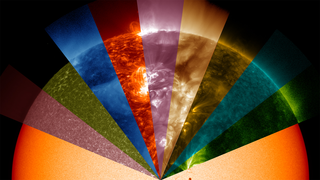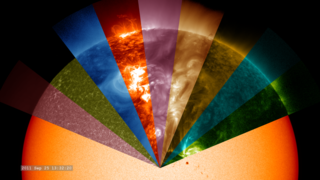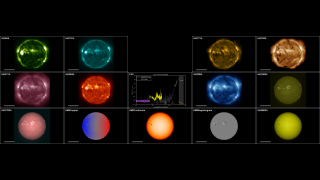Jewel Box Sun
A new NASA movie of the sun based on data from NASA's Solar Dynamics Observatory, or SDO, shows the wide range of wavelengths – invisible to the naked eye – that the telescope can view. SDO converts the wavelengths into an image humans can see, and the light is colorized into a rainbow of colors.
As the colors sweep around the sun in the movie, viewers should note how different the same area of the sun appears. This happens because each wavelength of light represents solar material at specific temperatures. Different wavelengths convey information about different components of the sun's surface and atmosphere, so scientists use them to paint a full picture of our constantly changing and varying star.
Yellow light of 5800 angstroms, for example, generally emanates from material of about 10,000 degrees F (5700 degrees C), which represents the surface of the sun. Extreme ultraviolet light of 94 angstroms, which is typically colorized in green in SDO images, comes from atoms that are about 11 million degrees F (6,300,000 degrees C) and is a good wavelength for looking at solar flares, which can reach such high temperatures. By examining pictures of the sun in a variety of wavelengths – as is done not only by SDO, but also by NASA's Interface Region Imaging Spectrograph, NASA's Solar Terrestrial Relations Observatory and the European Space Agency/NASA Solar and Heliospheric Observatory — scientists can track how particles and heat move through the sun's atmosphere.
Related
Credits
Genna Duberstein (USRA): Video Editor
Genna Duberstein (USRA): Producer
William D. Pesnell (NASA/GSFC): Scientist
C. Alex Young (NASA/GSFC): Scientist
Barbara Thompson (NASA/GSFC): Scientist
NASA's Goddard Space Flight Center
https://svs.gsfc.nasa.gov/11385
Mission:
SDO
Goddard TV Tape:
G2013-087 -- Argo Sun
Keywords:
SVS >> Coronal Loop
SVS >> HDTV
SVS >> Solar Wind
GCMD >> Earth Science >> Sun-earth Interactions
GCMD >> Earth Science >> Sun-earth Interactions >> Solar Activity >> Solar Active Regions
GCMD >> Earth Science >> Sun-earth Interactions >> Solar Activity >> Solar Flares
GCMD >> Earth Science >> Sun-earth Interactions >> Solar Activity >> Solar Ultraviolet
SVS >> Space Weather
SVS >> SDO
SVS >> Solar Dynamics Observatory
SVS >> Heliophysics
SVS >> Corona
NASA Science >> Sun
GCMD >> Earth Science >> Sun-earth Interactions >> Solar Activity >> Coronal Mass Ejections
GCMD keywords can be found on the Internet with the following citation: Olsen, L.M., G. Major, K. Shein, J. Scialdone, S. Ritz, T. Stevens, M. Morahan, A. Aleman, R. Vogel, S. Leicester, H. Weir, M. Meaux, S. Grebas, C.Solomon, M. Holland, T. Northcutt, R. A. Restrepo, R. Bilodeau, 2013. NASA/Global Change Master Directory (GCMD) Earth Science Keywords. Version 8.0.0.0.0














